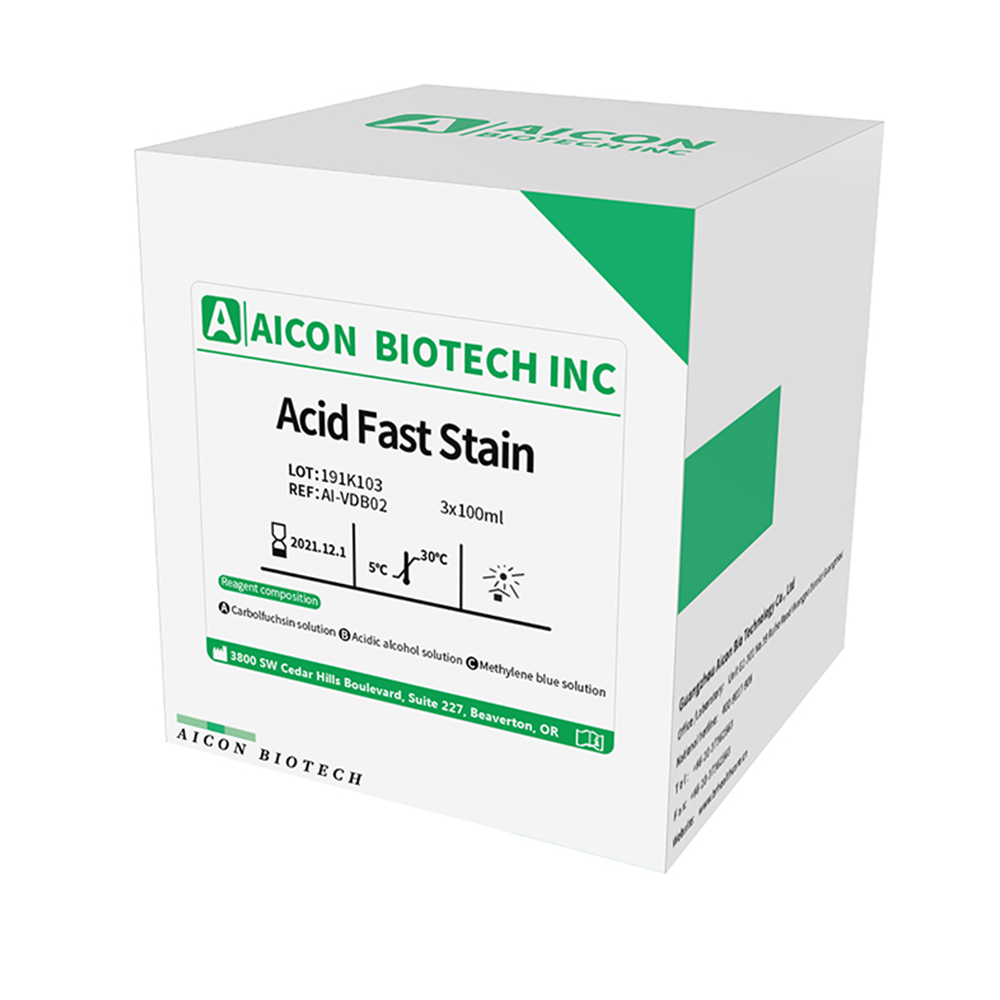Acid Fast Stain(100ml)
| Catalog Number | Unit Size | |||
| AI-VDB02 | 100ml | |||
Product name
English name: Acid Fast Stain(Kinyoun)
Package Specifications
3×100ml
Expected usage
For bacterial acid-fast staining of mycobacteria, Nocardia, etc., including fluorescent staining.
Test principle
An acid-fast bacterium such as Mycobacterium (such as Mycobacterium tuberculosis) is not easily colored because of a layer of lipid or lipid on the surface of the cell, but once it is colored, the action of the acidic alcohol solution is not easy to decolorize it. Using this characteristic and dyeing with enhanced staining solution, and then treated with acidic alcohol solution, the remaining non-antacid bacteria substances are decolorized and then contrast dyed. When counterstained with methylene blue solution, the mycobacteria are still red, non-anti-resistant. The acid bacteria and the background are blue. The methodology of this product is based on the standard Ziehl-Neelsen method recommended by the World Health Organization (WHO) and is mainly used for chemical staining of acid-fast bacteria such as mycobacteria. There are two common methods for acid-fast dyeing: 1. alkaline reddening method, also known as Ziehl-Neelsen’s method; 2. fluorescent dye method, including gold amine O method and gold amine O-rhodamine B method. This product uses a modified alkaline red complex method, which has the advantage of not requiring heating.
Main components
| Rengent component | Main ingredient |
| Carbolfuchsin solution | Carbol , basic fuchsin , Ethanol |
| Acidic alcohol solution | hydrochloric acid , Ethanol |
| Methylene blue solution | Methylene blue |
5 ºC~ 30 ºC protected from light, valid for 24 months. After the opening period, it is stored at 5 ºC ~ 30 ºC and protected from light. The validity period is 6 months.
Sample requirements
Pick about 0.05ml of cheese-like, pus-like or suspicious parts in the sputum specimen, and evenly spread it on the front of the slide into a 10mm´20mm oval round aponeurosis, which is naturally dry. Heated before dyeing.
Testing method
1. After the smear is naturally dried, it is placed on the dyeing rack, and the distance between the slides is kept at a distance of more than 10 mm; the heat is fixed (the slide is passed back and forth through the flame 4 times in 5 seconds);
2, add carbolic acid red complex solution covered with slides, staining at room temperature for 10 minutes or longer; (no heating step required)
3. The running water is lightly buffered from one end of the slide, washed away from the dye solution, and drained;
4, add acidic alcohol solution to cover the slide, decolorize for 1~2 minutes; if necessary, wash the acidic alcohol solution with running water, and then decolorize until the enamel film is not visible red.
5, running water from the end of the slide lightly buffered for 10~20 seconds, washed away the acidic alcohol solution, drain;
6. Dyeing with methylene blue solution for 30~ 60 seconds;
7. The running water is lightly buffered from one end of the slide, washed away, dyed, drained, and examined;
8. A stained glass slide with a bright blue color and no red plaque.
Explanation of test results
On a light blue background, the acid-fast bacteria are stained red, and other bacteria and cells are stained blue.
Limitations of inspection methods
It is limited to the staining of acid-resistant bacteria.
Precautions
1. Do not dry the dye solution on the slide when dyeing. When storing reagents, try to avoid high and low temperatures and direct sunlight.
2. After the acidic alcohol solution is used up, a 5% hydrochloric acid alcohol solution can be prepared as a decolorizing solution.
3. On the same acid-fasting bacteria, sometimes the situation of red shades may occur. Pay attention when observing.
4, after the application of the aponeurosis film cannot be too thick or too thin, in order to see the 5th word on the newspaper through the enamel film, the writing is relatively fuzzy, suitable thickness.
5. When the room temperature is too low in winter, the dyeing time should be extended appropriately.
6. Since cedar oil can dissolve the complex red dyeing liquid, the dyed material is discolored, and it is easy to dry and condense, causing damage to the oil lens. Therefore, it is forbidden to use cedar oil, and it is necessary to use the mirror oil for the microscope.
7. If you need to save the smear after observation, use oil filter paper or absorbent paper to blot the oil to the oil. Then use a cotton swab dampened with alcohol to gently wipe off the oil on the enamel film. The force of wiping should be small. Decor film.
8. After each reagent is used up, please cover it quickly to avoid evaporation.
9. This product should be used by professionals and the interpretation of the results.
10. Read the instruction manual carefully before use, use it within the validity period, and do personal protection.
11. Dispose of waste according to the requirements of the hospital or environmental protection department after use.
12. The production date, production batch number and expiration date are shown in the outer packaging.
Only logged in customers who have purchased this product may leave a review.

Reviews
There are no reviews yet.